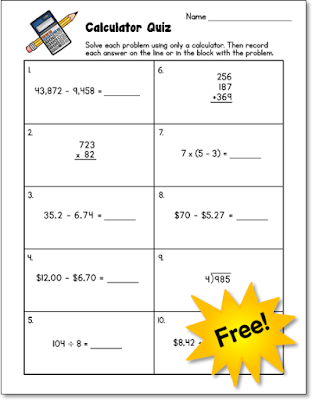When North Carolina first began to allow calculators on state tests, many elementary teachers (including me) were shocked! What? Kids need to develop basic computation skills before they are allowed to use calculators!
Then we got a look at the new state math test. Holy moly! The test was divided into two parts, a calculator-inactive section, and much longer calculator-active part that was made up entirely of word problems! I realized that if my 5th graders had to work out every answer by hand, they would never finish the test! I also realized that it wouldn't be fair to hand out calculators for the first time on test day. In short, I needed a new game plan.... one that involved calculators.
Calculators Are Not Magic - You Still Have to Think!
Most students are intimidated by word problems, so when I decided to introduce calculators, I felt that our problem-solving lessons would be a good place to begin. When I first handed out the calculators, my students were so excited! They seemed to think those calculators were going to magically solve the problems for them! It didn't take long before my students realized that calculators are not magic at all! Why?
- You still have to read the problem, choose a strategy, decide which operation to use, record the answer, and check the solution using a different strategy. In other words, you still had to THINK!
- Calculators aren't helpful with some types math problems, so you needed to know WHEN to use it and when it might be a waste of time.
- You have to know HOW to use the calculator in order to get the correct answer. The data from the problem must be entered in a specific way, and if you enter it incorrectly, you'll get the wrong answer every time.
- You have to know how to interpret the number that appears in the display window when you finish entering the data, especially in problems involved time, measurement, and money.
Why and How to Assess Calculator Skills
After they got over the disappointing realization that calculators are not magic, my students began to enjoy using them and looked forward to problem solving lessons.
However, I soon noticed that some students knew how to solve the math problems, but they were getting the answers wrong because they didn't know how to use their calculators properly. Time for some calculator lessons! I knew that some kids didn't need the extra help, so I created a simple 10-item Calculator Quiz to find out who did. You can download this free assessment from my
Daily Math Puzzlers page. When I handed out the test, I told my students that they were not allowed to work out any problems on paper. They were required to use their calculators and they could only use their pencils to record their answers. Needless to say, they were shocked! "You mean we can't work out the problems on paper even if we WANT to?" "Nope. Sorry. Only the calculator."
After I scored the tests, I taught several guided math group lessons to the students who were having difficulties. The other students used the time to work on math center activities. Then I retested the kids who I had worked with to be sure they had mastered the basic calculator skills. These lessons were so successful that I included calculator instruction in each
Daily Math Puzzler book.
6 Reasons to Teach Calculator Skills to Upper Elementary Students
So why should we teach upper elementary students how to use a calculator? Based on my own experiences and feedback from other teachers, I am convinced that calculators boost mathematical thinking and are motivating to students. Here are 6 reasons to teach calculator skills and to encourage your students to use them to solve math problems.
- Calculators help kids overcome computational limitations.
Kids often have the conceptual understanding to solve problems that are much more difficult than their computational ability would allow. For example, a student might know they need to divide a 2-digit number by another 2-digit number, but if he or she hasn't mastered this skill, the answer will be out of reach without a calculator. Overcoming computational limitations is especially helpful for special needs students and actually removes barriers to more advanced levels of math instruction.
- Calculators encourage the use of multiple strategies.
Being able to use a calculator frees students to consider and test out a wide variety of problem solving strategies in a short time. They can solve a problem using one strategy (without or without a calculator), and check their answers using a different strategy.
- Calculators help kids solve more problems in less time.
Calculators allow students to work more quickly, which means they can solve more problems in a given time. So you can increase the number and complexity of the problems you introduce in each lesson without increasing the time devoted to problem solving lessons.
- Calculators promote persistence in problem solving.As students begin to think more creatively and try different methods, they will experience success with some methods and failure with others. But it's HOW they feel about those "failures" that's important. I noticed my students were less discouraged when they couldn't solve problems quickly; they tried to figure out WHY their methods didn't work. Then they adjusted their thinking and tried a different strategy.
- Calculators foster a growth mindset.Educators are starting to realize that praising students for correct answers is not nearly as important as recognizing their struggles along the way. When students are able to persist and try different strategies to solve challenging problems, they feel a sense of accomplishment and pride in themselves for not giving up which leads to the next benefit.
- Calculators promote a positive attitude towards problem solving. As the saying goes, "Success breeds success," and that's definitely true in math. Using a calculator drastically increases the chance that a student will get the correct answer, and the subsequent feeling of accomplishment promotes a more positive attitude toward the next problem.
What If Your Students Are Not Allowed to Use Calculators on Standardized Tests?
Is there any benefit to using calculators during the school year if your students are not allowed to use them on standardized tests? Yes! Your students will still benefit from using them early in the year to boost their mathematical thinking, as long as you devote sufficient time to teaching and reviewing computation. As the year progresses and your students' computation skills improve, you can gradually wean them off calculators completely.
When Should Calculators Be Introduced?
I introduced calculator skills early in the year because my students were 5th graders who had developed a fairly solid understanding of numbers and what they mean. I don't advocate giving them to young children who have not had time to develop number sense, because entering numbers into a calculator won't be meaningful to them. You are the best judge of when your students are ready to begin using calculators. However, if you observe your students randomly punching numbers in as if they are hoping to stumble on the answer, it might be time to put the calculators away for a while and focus on math problem solving strategies.

Learning to use a calculator had a tremendous positive impact on my students' mathematical thinking and their willingness to tackle tough problems. Furthermore, because I still taught computation skills, I didn't see any detrimental impact on their ability to solve computation problems without a calculator. If you think about it, calculators are just another math tool. No, they won't magically solve word problems. However, the way calculators help students become better problem solvers IS almost magical!
 Most spelling lists include unrelated words, so students must be very creative in order to include at least 10 of them. I don't mind if the stories are short as long as they meet the requirements. Sometimes the funniest and most creative stories are the shortest ones! I'll bet you have at least one student who likes to take shortcuts on assignments. If your students are like mine, they will write the most hilarious stories just to get the assignment done with the fewest words possible! Click the story on the right to read Derrick's story, a perfect example of creativity unleashed! He used 14 words in a story that wasn't even a full page long.
Most spelling lists include unrelated words, so students must be very creative in order to include at least 10 of them. I don't mind if the stories are short as long as they meet the requirements. Sometimes the funniest and most creative stories are the shortest ones! I'll bet you have at least one student who likes to take shortcuts on assignments. If your students are like mine, they will write the most hilarious stories just to get the assignment done with the fewest words possible! Click the story on the right to read Derrick's story, a perfect example of creativity unleashed! He used 14 words in a story that wasn't even a full page long. 








